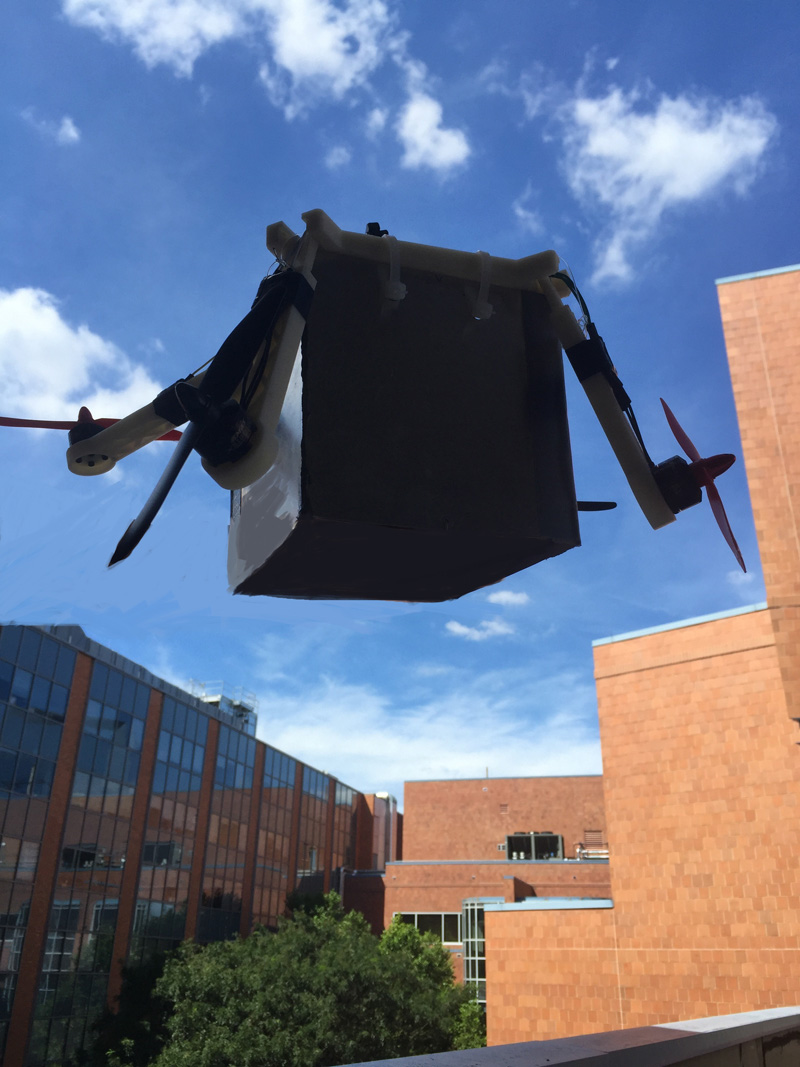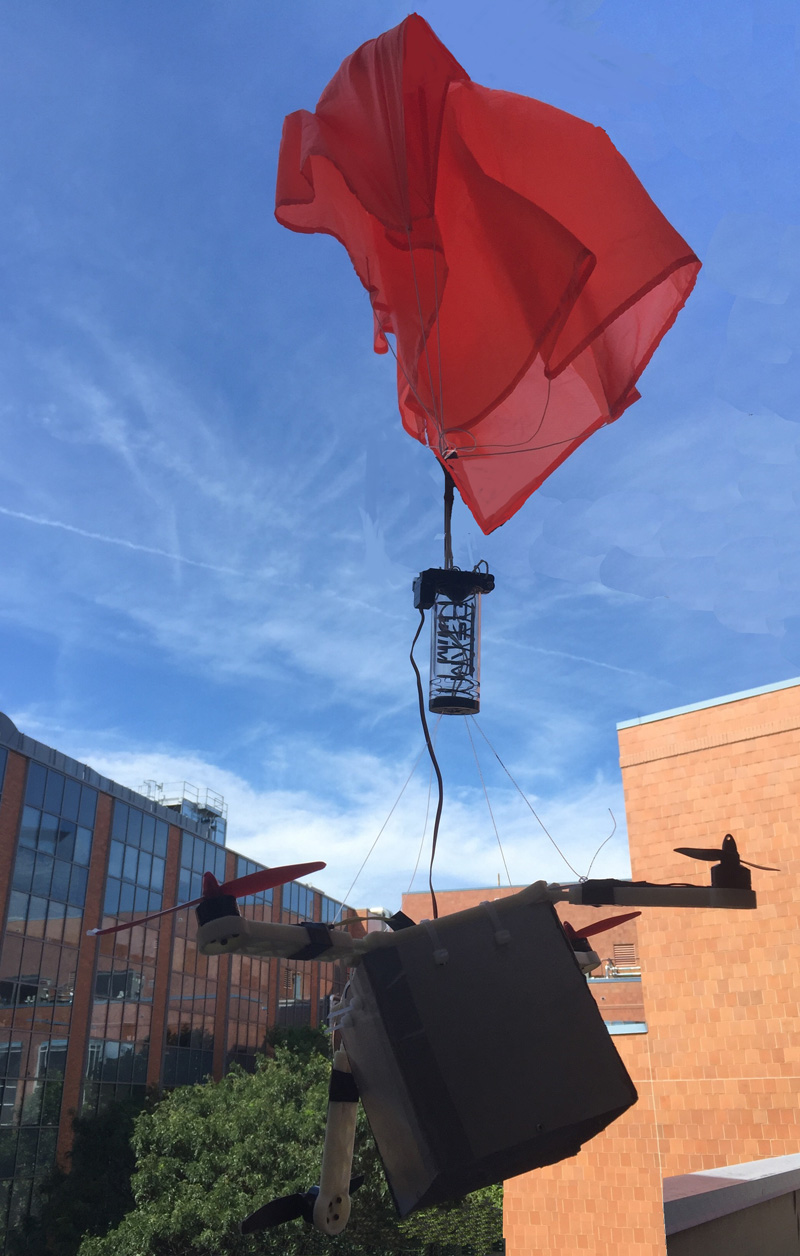By Lini S. Kadaba
The challenge: Prove the practicality of a compact cube-shaped vehicle transforming into a drone, navigating to a particular destination and then dropping its payload at the targeted spot.
 Over the summer, three rising mechanical engineering sophomores in the Students Tackling Advanced Research (STAR) Scholars Program took on this ambitious task. The result is a prototype that shows promise in its early stages. So-called drop vehicles can be used to deliver food and medical care packages to war zones, online orders to front doors or ultimately, probes to outer space to explore planets.
Over the summer, three rising mechanical engineering sophomores in the Students Tackling Advanced Research (STAR) Scholars Program took on this ambitious task. The result is a prototype that shows promise in its early stages. So-called drop vehicles can be used to deliver food and medical care packages to war zones, online orders to front doors or ultimately, probes to outer space to explore planets.
“We built this drone from scratch,” says Kevin Legge ’20, 19 of Mantua, N.J. He worked on the 15-cm cube-to-drone device that weighs about a pound with Esther Choi ’20, also 19, of Saipan in the Northern Mariana Islands. Htet Naing Aung ’20, 18, of New York City via Myanmar, designed the launch platform. Jason Avery ’17, a junior, also helped.
All three STAR Scholars are interested in the aerospace industry.
“The most exciting part for me was designing the frame of a drone,” says Legge, a newbie to drones. He and Choi used 3-D modeling software to create the frame and then a 3-D printer to manufacture it. “It’s something I can say I made. That’s mine. I think it’s awesome.”
Over 10-weeks, Legge and Choi researched how to build drones and then ordered parts to be attached to the frame. The project was under the auspices of Ajmal Yousuff, PhD, an associate professor of mechanical engineering.
“Kevin and I weren’t really sure we chose the right materials,” Choi allows. “However, when the parts arrived and I got my hands on those, I really loved putting them together and seeing a bunch of different electronics slowly form into a drone. I guess I’m a MEM major for a reason, since I just can’t hide my excitement when I’m building things with my own hands.”
 The goal was to make the vehicle compact for storage on the launch platform-- hence the cube-- and then transform into an X-shaped drone once released. A parachute that deploys at release pulls the four arms holding the drone’s motors upward and locks them into place on the vehicle’s frame. At that point, the drone, guided wirelessly, can fly to its destination.
The goal was to make the vehicle compact for storage on the launch platform-- hence the cube-- and then transform into an X-shaped drone once released. A parachute that deploys at release pulls the four arms holding the drone’s motors upward and locks them into place on the vehicle’s frame. At that point, the drone, guided wirelessly, can fly to its destination.
“We basically had all the separate parts and worked on it, designing from the ground up,” Legge says.
Meanwhile, Aung designed and assembled his light-weight, scalable, 3-foot-by-3-foot, X-shaped platform design, also from scratch. The primary goal was to maintain its horizontal position at a high altitude while being able to release drop vehicles wirelessly on command. Another important goal was to keep the total weight of the platform with onboard sensors and other electronics and drop vehicles under 16 pounds so that only a single high-altitude balloon is needed to lift everything to the height of a 30-story tall building. “The hardest part was to figure out if my frame design was going to be reliable,” he says, “with constant wind at that height.”
Even though the students have a prototype, they still have a ways to go. The three have continued to find time around co-ops to perfect the launch platform and drop vehicle, saying they want to see the project through to its end. So far, they have tested the concept at a height of a few feet, essentially holding the drop-vehicle up as high as possible and then letting it go.
“This project was a proof of concept, to show that this is possible, that we can get this to work,” says Legge.
According to Dr. Yousuff, the students proved capable. “They helped the project advance by being creative and by prototyping the ideas,” he says. “This is a step forward in realizing the goals of the project.” Ultimately, Yousuff would like to hold a drop vehicle competition on campus to discover the most efficient way to deliver packages and probes.
 Choi, who participated in drone-making competitions in high school, says she is proud of what she and the others have accomplished so far. “Drones are the ones that first made me think about majoring in engineering, so they are somewhat special to me,” she says.
Choi, who participated in drone-making competitions in high school, says she is proud of what she and the others have accomplished so far. “Drones are the ones that first made me think about majoring in engineering, so they are somewhat special to me,” she says.
“I have long been interested in working with drones for real-life applications,” adds Aung. For him, the challenge ahead is ensuring the platform—made of carbon fiber, fiberglass, and rigid and light-weight foam—performs its tasks reliably even at high altitudes.
At the moment, the drop vehicle also is very shaky. “We’re having trouble with motors, getting them calibrated,” Legge allows. “We have a lot of tweaking to do.”
Eventually, they want to test the drop vehicle at a greater height, but only after it’s close to perfection.
“We want to be 100 percent certain that when we drop it from a 100 feet or so, it’s able to land safely,” Legge says. “After all this work, we don’t want it to crash.”